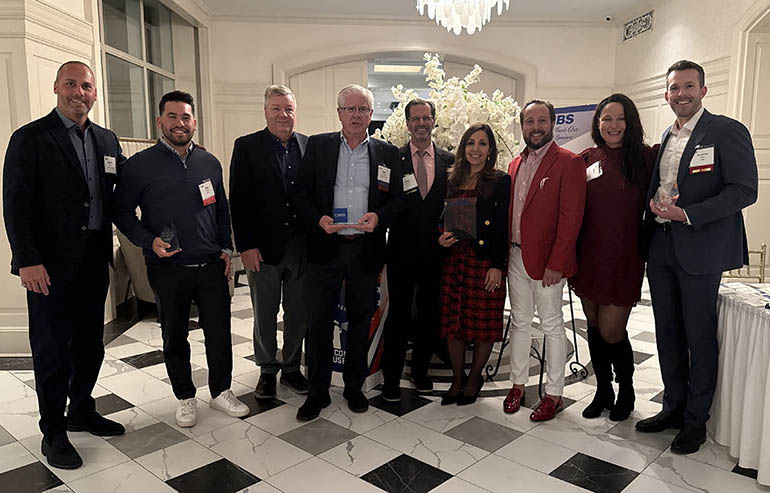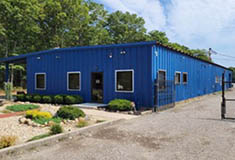News:
Long Island
Posted: November 10, 2014
BBS completes $29.8 million William J. Lindsay Life Sciences Building; Assisted by J. Petrocelli Contracting; Aimed for LEED Gold
Suffolk County Community College (SCCC) leadership, local and state elected officials, community leaders, and representatives of BBS Architects, Landscape Architects and Engineers and J. Petrocelli Contracting have officially opened the new, $29.8 million William J. Lindsay Life Sciences Building.
The educational and research facility is named in honor of Suffolk County legislator, a former presiding officer of the Suffolk County legislature, and a long-time supporter of the SCCC, who passed away in 2013. BBS served as architect; interior designer; and civil, mechanical, and electrical engineer for the new building. The building is aiming at LEED Gold certification, indicating a high level of sustainability in design and construction.
The Life Sciences Building is the first new academic structure completed on the Ammerman Campus in 50 years. It will house programs for students pursuing biology, marine biology, chemistry, environmental science, and nursing degrees. A rapidly growing enrollment in life sciences disciplines such as biology, chemistry, environmental science, and nursing necessitated the construction of the new facility. Approximately 5,000 students will attend classes in the building throughout the spring semester beginning in January 2015. The building will also allow for the expansion of science classes to include an additional 100 students in the spring and 300 students next fall.
"The William J. Lindsay Life Sciences Building demonstrates our institutional commitment to invest in students and provide what is needed for a state-of-the-art education," said SCCC president Dr. Shaun McKay.
BBS principal architect Roger Smith, AIA, LEED AP, said, "The $29.8 million, 63,000 s/f structure is designed to serve as a learning tool itself. It incorporates pioneering sustainability and educational features, such as interactive boards displaying - in real time - the building's sustainability data and power performance. It is a very cool feature, you can literally walk around and watch the building work."
"The construction team collaborated closely with the college and the designers to ensure that the school's daily operations were not impacted by the construction work. Our site management team has closely coordinated noisy construction activities and deliveries with the campus leadership and ensured that roads and walkways adjacent to the building site remained safe and opened to traffic," said Joseph Petrocelli, treasurer at general contractor J. Petrocelli Contracting. "In addition, our team employed sustainable construction and recycling practices in order to protect the site's environmental integrity, healthy indoor environment for students and faculty, and support the project's LEED certification procedures."
More then 200 dignitaries, political leaders, and elected officials have attended the opening ceremony, including chairman of the State University of New York (SUNY) Board of Trustees H. Carl McCall; Suffolk County Executive Steve Bellone; Suffolk's Presiding Officer DuWayne Gregory; Suffolk County Minority Leader John M. Kennedy; Suffolk County Legislator Sara Anker, Chair of the County's Education Committee; Congressman Tim Bishop; New York State Senator and Chairman of the State's Select Committee on Higher Education Kenneth P. LaValle; New York State Senator and Chairman of the State's Select Committee on Education John Flanagan; New York State Assemblyman Al Graf; and New York State Assemblyman Philip Ramos.
With more than 25,000 students enrolled at three campuses, Suffolk County Community College is the largest community college in New York State. The 156-acre Ammerman Campus in Selden, opened in 1961, is the oldest and largest of the college's three campuses and enrolls over 14,000 students.
Other team members include general contractor J. Petrocelli Contracting, science lab design consultant Tsoi/Kobus & Associates, site designer Greenman-Pedersen, structural engineer Ysrael A. Seinuk, and plumbing engineer Bladykas Engineering.
The building's design won the 2011 School Planning & Management magazine's Sustainability and Innovation Award in the Building as a Teaching Tool category.
New York State and Suffolk County financed the project in equal parts.
Architecture and site design
BBS won the commission in a competition that attracted numerous prominent design firms from across the nation. According to Smith, "The architectural approach that convinced the client to select our design focused on five aspects of the new building. These were the concept of a "building as a learning tool," expressed through technology and site design; visualizing the vocabulary of biology through architecture and programming; encouraging the interaction and exchange of ideas among students and faculty; incorporating the structure into the natural environment of the site; and implementing a high number of sustainable features into engineering and architecture of the facility."
"The design team embarked to express the natural organization of organs and nerve systems in its approach to implementing the school's program through interior layouts, architectural organization, traffic patterns and connections to the overall campus for the new building," explained BBS Director of Architecture Joseph B. Rettig, AIA, LEED AP. "They were inspired by the concept of a plexus and connecting nodes, which is represented in the design of the structure's central rotunda and wings as well as in the organization of hallways and building systems in the new school," he added.
The building creates a new identity for scientific education programs at the college by displaying the school's inner works to passersby and visitors. The building is designed to integrate its teaching functions with the campus circulation by utilizing a major pedestrian path from the south, leading to the main quadrangle, to encourage transit through the building by students and faculty from all disciplines. The overall program also includes construction of a new 314-square-foot astronomical observatory at a separate location.
The Life Sciences Building's location and design reflect and enhance the existing pathways and spatial relationships already in place on campus. Taking advantage of the changing grade of the site, a north entrance will receive students and faculty coming from the Riverhead and Smithtown Science buildings at the second floor level. To the south, where the grade drops one full story, another entry serves students and faculty arriving from the parking area to the southeast and adjacent athletic facilities to the southwest at the first floor level.
"The architectural and planning concepts are fundamentally sustainable. The east-west orientation of the building minimizes summer solar heat gain. The integration into the land contours reduces the exterior surface area, and the overall space efficiency minimizes the material and construction resources. The high efficiency mechanical and electrical systems are designed to provide safe and functional operation, while significantly minimizing the energy use," said Rettig. The BBS engineering team critically analyzed the air change rates required for each type of the interior spaces and optimized the mechanical system to accommodate the findings.
Other sustainable features of the structure include the "tight envelope" and high levels of insulation reducing the thermal losses; a natural storm water run-off management systems; high recycled content and locally sourced materials; and high efficiency lighting system with occupancy sensors.
In addition, a rooftop photovoltaic system will generate 144 kilowatts of electricity and provide over 60 percent of the building's electric needs, saving approximately $48,000 per year.
The school's exterior brick veneer panels convey a sense of "earthen" physicality through the use of color, texture and pattern. This material reflects the look of existing brick campus buildings. However, in order to engage the mind of the observer, the façade features changing patterns. Aluminum and glass curtain wall surfaces the voids of the building, thus allowing high amounts of light to enter the interior.
Both the interiors and the site feature learning tools related to the building's operations, design, and function. The school' interiors house kiosks and interactive boards displaying - in real time - the building's sustainability data and power and HVAC systems' performance.
The sustainability in site design is visible along the pedestrian paths and around the outdoor classrooms. The site features gardens, a contained drainage system, and storm-water-collection swales with native, drought-resistant vegetation. Student gathering areas are located near the most interesting sustainable elements and main landscaping features of the site. The ecosystem of the site encourages study of nature.
The site design embraces the overall project concept in many ways. It provides a highly sustainable environment that employs native plant selections to minimize maintenance requirements and provide biodiversity and habitat for indigenous fauna. The storm drainage system, a combination of natural and artificial features, accommodates the life sciences building and site as well as the main campus' rainwater flows that currently enter the site. While designed to be sustainable and functional, this treatment also provides opportunities for educational experiences as displays of applied science. The functional purpose of the site, the way it is shaped, and the use of native grasses, perennials, shrubs, and trees represents a reinvigorated appreciation of the natural aesthetic required for current and future sustainable and reasonable development.
Interior design
According to BBS interior designer Tracy Hansen, RA. "The building is arranged with two wings around a central rotunda, which serves as both a transit and a gathering point for students. Each wing has a single laboratory corridor, which provides clear orientation as well as efficiency and visibility. The corridors feature active exhibits and serve as informal meeting places for students, activating the building as seen from the exterior."
The south-facing window wall has been designed to modulate and harvest natural light. Classroom spaces at the second and third floors feature internal glass walls to take advantage of light and views to the south. Seating opportunities in the corridors/ public spaces provide settings for impromptu conversations or short breaks before entering classrooms.
The building's layout provides a high degree of space efficiency. The two wing corridors provide direct access to all laboratory and support spaces. Stairways for egress at the ends of the two wings, and the central open stair, designed for dramatic architectural impact, ensure safe and convenient access to all floors.
The simple circulation systems and central core rotunda, as well as the mixed locations of the several scientific disciplines housed within the structure, encourage meetings and interaction among students and faculty. Additional informal meeting spaces along the laboratory corridors promote a dialogue and exchange of ideas among the building's occupants.
The building's first floor houses the main lobby; elevator shaft; three anatomy and physiology laboratories with prep rooms and 24 stations each, ranging in size from 1,214 to 1,331 square feet; four flexible lecture halls ranging in capacity from 48 to 72 seats; faculty office; 1,706-square-foot main lobby student gathering space; 221 square feet of corridor niche meeting spaces; and storage and utility rooms.
The lobby is designed as an indoor amphitheater cut into the slope of the building's site. Classes can be taught in this space. The elevator shaft features interactive kiosks on each of the three building levels. The atrium video wall is made up of 16 NEC 46-inch LED ultra-narrow bezel monitors set up in a 4-foot by 4-foot grid. It is 13.43 feet wide by 7.6 feet high.
The second floor houses general, marine, and microbiology facilities. These include six labs ranging in size from 1,214 to 1,331 square feet; prep rooms and assistants' offices; a 630-square-foot faculty office suite and three 80-square-foot faculty offices; a 160-square-foot biology walk-in cold storage room; student gathering niche; a 24-station student computer room; a 14-station student project room; and support facilities. Each of the six laboratories feature 24 stations.
The building's third floor features two 1,214-square-foot chemistry labs; two 1,214-square-foot, 48-seat general classrooms; a 936-square-foot, 24-station computer room; a 529-square-foot conference room; a 613-square-foot faculty lounge with a 221-square-foot kitchenette; two faculty offices; a reception area for administrative offices; department management offices; student gathering areas; mechanical, electrical and storage rooms; and an outdoor vegetated roof.
The building also houses four environmental rooms, ranging in size from 40 to 160 square feet and manufactured by Darwin Chambers Company.
The interiors feature numerous sustainable and recycled materials. These include 1,200 square feet of an unusual natural bamboo veneer wall paper, installed on the curved outside wall of the elevator shaft. This material was manufactured in Japan.
Laboratory spaces are designed using modular planning principles. Each space is essentially the same size to allow flexibility in layout and lab furniture components. Fixed functions such as sinks and fume hoods are located at the perimeter. Laboratory workstations include gas, air, power, and water connections. The building's mechanical system is sized to provide appropriate air changes for biology labs throughout the several life science disciplines. This solution reduces the energy use.
The classrooms and laboratories feature custom manufactured cabinetry by CampbellRhea, epoxy resin countertops, and Orion Style 8 1.5-gallon chemical neutralization tanks underneath sinks. The flooring consists of vinyl enhanced tiles (VET), solid vinyl tiles (SVT), and carpet on the atrium's six seating steps and in offices.
The exterior aluminum composite wall panels are also utilized inside the atrium for visual continuity of the structure's exterior and interior. The atrium features curved internal balconies with a ½-inch tempered glass handrail system with maple wood veneer rails. Curved steel members support the balconies.
Construction
"The project team faced several technical and logistical challenges during construction of the new Life Sciences Building. These included a curved curtain wall and a complex steel structural frame that features curved members, the need to accommodate daily pedestrian traffic bordering the construction site, a significantly sloping site, and pre-existing site conditions that necessitated a high amount of new control fill material," explained Petrocelli Senior Site Superintendent Mark Evans.
The structure features expansive curved exterior walls on south and north sides. The steel fabricator, manufactured and delivered structural elements in sections up to 20 feet long. Due to the curvature of the central section of the building and the unusual five-inch mullions between glaze panels, the support system for the exterior glass curtain wall was custom designed and manufactured. It features connecting clips welded to the building's steel structure. Aluminum tubing, which supports the glass panels, is attached to the clips. On the south side of the building, the expansive glazed curtain wall is approximately 150 feet wide and 45 feet high. The glazing features energy efficient low-e glass. The crews installed it from an exterior scaffolding that matched the curvature of the wall.
"The large campus remained in operation throughout construction," said Petrocelli Senior Project Manager Philip A. Florie. "As part of the project, Petrocelli resurfaced and expanded a nearby parking lot, which remained in use during the development process. A walkway with a very high volume of daily pedestrian traffic that leads from the parking lot to various buildings of the campus crosses the site of the new Life Sciences Building. In order to protect passersby during construction activities, the Petrocelli team erected temporary walls and created a temporary pathway for students and faculty," he added.
The building features concrete foundations and a steel structural frame. The foundation reaches up to 15 feet down on the north site of the building. During the excavation phase, the crews replaced the soil within the entire footprint of the building with control fill in order to ensure the required bearing capacity of the soil. Because the site slopes from north to south, the team installed an extensive shoring wall on north and east sides of the excavation site. The 300-foot long shoring system consisted of steel I-beam piles driven up to 30 feet down and connected by timber walls up to 15 feet high.
In addition to the glazed curtain wall, the building features contrasting aluminum panel sections and concrete masonry unit (CMU)and brick veneer exterior walls. In order to create a highly energy efficient building envelope, the designers created a multi-layered walls that consist of an internal CMU wall, three inches of a spray-on thermal insulation, a two-inch air barrier, and the exterior brick veneer.
The aluminum curtain wall consists of Alpolic aluminum faced composite panels manufactured by Mitsubishi Plastics Composites America. The lightweight panels feature a core of thermoplastic material thermally bonded to face sheets fabricated of aluminum 3105 H14 alloy, 0.020-inch thick.
The building's roof houses six fans that serve 12 fume hoods in the laboratories as well as four smoke purging fans. The rooftop systems also include six Trane cooling and heating units, each approximately 40 feet long and 10 feet wide. Each unit services a dedicated section of the building. The interiors also feature 145 VAV hot water space heaters that supplement the rooftop-based units.
As part of the environmentally responsible construction process, Petrocelli sorted and recycled a significant portion of the construction debris. In order to protect the quality of air inside the building, all HVAC ductwork was covered during delivery and installation, which prevented contamination with dust.
The building is equipped with a Trane Building Management System (BMS) that optimizes energy use and controls life safety systems. The building underwent a commissioning process, which ensures all systems operate correctly and efficiently.
Suffolk County Community College
Suffolk County Community College (SCCC) is the largest community college in the State University of New York (SUNY) system, enrolling more than 26,000 students at its three campuses in Selden, Brentwood, and Riverhead. Approximately 15,000 students are enrolled at the Ammerman Campus. SCCC offers the Associate in Arts (A.A.), Associate in Science (A.S.), and Associate in Applied Science (A.A.S.) degrees, as well as a variety of certificate programs. Offering affordable college tuition, a highly respected Honors program, extensive extracurricular activities, championship athletic teams, and numerous transfer programs, SCCC is a first-choice college for Long Island students. Visit us online at sunysuffolk.edu.
BBS Architects, Landscape Architects and Engineers
Headquartered in Patchogue, NY and established in 1975, BBS Architects, Landscape Architects and Engineers is a leading Long Island and NY/NJ/CT Tri-state area designer of sustainable educational, commercial, institutional, public and athletic facilities. The firm designed the first LEED-certified public school in New York State, the Hampton Bays Middle School in Hampton Bays, N.Y., which received a LEED Silver certification as well as the 2012 Green Ribbon School designation from the White House and the U.S. Department of Education. Over the last decade, BBS has designed educational facilities valued at nearly $2 billion. The firm's services include architecture, interior design, and landscape architecture as well as civil, mechanical, electrical, and plumbing engineering.
BBS' current and recent work includes the new $26-million Life Sciences Building at the Suffolk County Community College Ammerman Campus in Selden, N.Y., which is targeting LEED Gold certification; the 100-room Hyatt Place East End hotel in Riverhead, N.Y.; Long Island University's $1.6-million Mullarkey Hall renovation in Brookville, N.Y.; the $78-million Riverhead Central School District Capital Program in Riverhead, N.Y.; the new, three-st
ory, 25,500-square-foot addition at the Southampton Elementary School in Southampton, N.Y.; the Holy Sepulchre Cemetery Administrative Building in Coram, N.Y.; the 24,000-square-foot Brown's Fiat dealership in Medford, N.Y.; and the new Sacred Heart Roman Catholic Church in North Merrick, N.Y.
J. Petrocelli Contracting, Inc.
John M. Petrocelli, Sr. founded J. Petrocelli Contracting in 1959. The family-owned construction management and general contracting firm operates out of a 30,000-sq.-ft. facility that houses 75 full-time employees. The company provides construction services to a full spectrum of commercial, institutional, and public clients and builds projects throughout the Greater New York area, including New York City and Long Island.
Petrocelli's current and recent projects include the 80,000-sq.-ft. Hauppauge Office Park in Hauppauge, N.Y.; a 470-apartment condominium tower in Long Island City, N.Y.; the six-story 544 Union Avenue condominium tower in Brooklyn, N.Y.; the 100,000-sq.-ft. Gouverneur Healthcare building expansion in New York, N.Y.; and the 100-room Hyatt Place east End in Riverhead, N.Y.
***
Photo credit and caption
FILE: SCCC Life Sciences Bldg exterior south 680 med.jpg
BBS Architects, Landscape Architects and Engineers and J. Petrocelli Contracting have completed the $29.8-million William J. Lindsay Life Sciences Building at the Suffolk County Community College's Ammerman Campus in Selden, N.Y.
Photo by Peter Wilk/Wilk Marketing Communications
FILE: BBS SCCC Life Sciences Bldg opening 766 med.jpg
Political and community leaders, representatives of the college and the design and construction team, and family members of late former Presiding Officer of the Suffolk County Legislature William J. Lindsay celebrated the opening the $29.8-million William J. Lindsay Life Sciences Building at the Suffolk County Community College's Ammerman Campus in Selden, N.Y.
Left to right, seating: Suffolk County Legislators Monica Martinez, Kate Browning, William Lindsay, Kara Hahn, and Sarah Anker.
Left to Right, standing: BBS Architects Principal Roger Smith, Suffolk County Legislator Lou D'Amaro, J. Petrocelli Contracting Treasurer Joseph Petrocelli, Suffolk County Legislators Tom Cilmy, Robert Trotta, and Robert Calarco, Suffolk County Representative at New York State Governor Andrew Cuomo's office Scott Martella, President of the Nassau-Suffolk Building and Construction Trades Council Richard O'Kane, New York State Assemblyman Mike Fitzpatrick, New York State Assemblyman Phil Ramos, SCCC President Dr. Shaun L. McKay, Suffolk County Legislator Thomas Barraga, SUNY Chairman of the Board of Trustees H. Carl McCall, New York State Assemblyman Al Graf, New York State Assemblyman Chad Lupinacci, New York State Assemblyman Steven C. Englebright, Suffolk County Legislators John M. Kennedy, Jr. and Jay Schneiderman, Suffolk County Executive Steven Bellone, Suffolk County Legislature Presiding Officer DuWayne Gregory, New York State Senator Ken LaValle, Suffolk County Legislator Al Krupski, and Town of Brookhaven Town Supervisor Ed Romaine.
Photo courtesy of Suffolk County Community College
FILE: BBS SCCC Life Sciences Bldg interior 01 med.jpg
The classrooms and laboratories feature custom manufactured cabinetry by CampbellRhea, epoxy resin countertops, and Orion Style 8 1.5-gallon chemical neutralization tanks underneath sinks. The flooring consists of vinyl enhanced tiles (VET), solid vinyl tiles (SVT), and carpet on the atrium's six seating steps and in offices. Laboratory work stations include gas, air, power, and water connections.
Photo courtesy of Suffolk County Community College
FILE: BBS SCCC Life Sciences Bldg 8803 med.jpg
The Life Sciences Building features aluminum composite and glass curtain wall, and CMU walls with a brick veneer.
Photo courtesy of Suffolk County Community College
FILE: BBS SCCC Life Sciences exterior 03 med.jpg
The sustainability in site design is visible along the pedestrian paths and around the outdoor classrooms. The site features gardens, a contained drainage system, and storm-water-collection swales with native, drought-resistant vegetation. Student gathering areas are located near the most interesting sustainable elements and main landscaping features of the site. The ecosystem of the site encourages study of nature.
Photo courtesy of Suffolk County Community College
Tags:
Long Island
MORE FROM Long Island
Suffolk County IDA supports expansion of A&Z Pharmaceuticals
Hauppauge, NY The Suffolk County Industrial Development Agency (IDA) has granted preliminary approval of a financial incentive package that will assist a manufacturer in expanding its business by manufacturing more prescription (Rx) pharmaceuticals in addition to its existing over-the-counter

Quick Hits
Columns and Thought Leadership

The evolving relationship of environmental consultants and the lending community - by Chuck Merritt
When Environmental Site Assessments (ESA) were first part of commercial real estate risk management, it was the lenders driving this requirement. When a borrower wanted a loan on a property, banks would utilize a list of “Approved Consultants” to order the report on both refinances and purchases.








.gif)
.jpg)